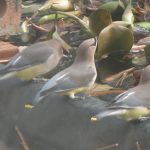Cedar Waxwing
Bombycilla cedrorum
Cedar Waxwings are not common around Lake Norman but may occasionally be seen. The photos above were taken in late November 2005 in Mooresville. They are smaller than a Robin (about 6″ to 7″ long) and almost always found in flocks.
The Cedar Waxwing (Bombycilla cedrorum) is a member of the family Bombycillidae or waxwing family of passerine birds. It breeds in open wooded areas in North America, principally southern Canada and the northern United States. Movements outside the breeding season are erratic, but most of the population migrates further south into the United States. It is very rare vagrant to western Europe, with two recorded occurrences in Great Britain.
Cedar Waxwings eat berries and fruit year-round, including arils of the yew, with insects becoming an important part of their diet in the breeding season. Its fondness for the small cones of the Eastern Redcedar (a kind of juniper) gave this bird its common name. This species is eruptive, moving south in huge numbers if the berry supply fails in winter. It feeds in flocks outside of the nesting season. When the end of a twig holds a supply of berries that only one bird at a time can reach, members of a flock may line up along the twig and pass berries beak to beak down the line so that each bird gets a chance to eat.
Birds in winter can be very confiding and will come into gardens for berry bushes and trees.
Its flight is strong and direct, and in flight, it looks like a small pale starling. It is smaller and browner than the Bohemian Waxwing, which breeds further north and west than the Cedar Waxwing in the North American part of its range. The tail is tipped with yellow, or orange in birds that have fed on berries of introduced Eurasian honeysuckles while growing tail feathers after molt. Adults have a pale yellow belly. Immature birds are streaked on the throat and flanks, and often do not have the black mask of the adults.
The nest is a loose open cup built with grass and twigs, lined with softer materials and supported by a tree branch averaging 2 to 6 meters above ground but, at times, considerably higher. The outer diameter of the nest is approximately 12cm to 16cm.
During courtship, the pair may pass a flower petal or insect back and forth repeatedly. Usually, 4 or 5 eggs are laid and the female incubates them for 12 to 16 days. The eggs are oval shaped with a smooth surface and very little, if any, gloss. The egg shells are of various shades of light or bluish grey with irregular, dark brown spots or greyish-brown splotches. Both parents build the nest and feed the young. Typically, there are two broods during the mating season. Young leave the nest about 14 to 18 days after hatching.
The calls of these birds include very high-pitched whistles and buzzy trills often represented as “see” or “sree”.
Cedar Waxwings are also known as the Southern Waxwing, Canada Robin, Cedar Bird, Cherry Bird, or Recellet.
According to experts in the writing of Vladimir Nabokov, this species is almost certainly the waxwing mentioned prominently in his novel Pale Fire.
Waxwings are protected by US Law and may not be kept in captivity.
The text within the green border is licensed under the GNU Free Documentation License. To see the full article with more information, visit the Wikipedia article “Cedar Waxwing“. All content outside the green border is copyrighted by McBryde Website Design.
For more information from the USGS (United States Geological Survey)
on the Cedar Waxwing, click here.


